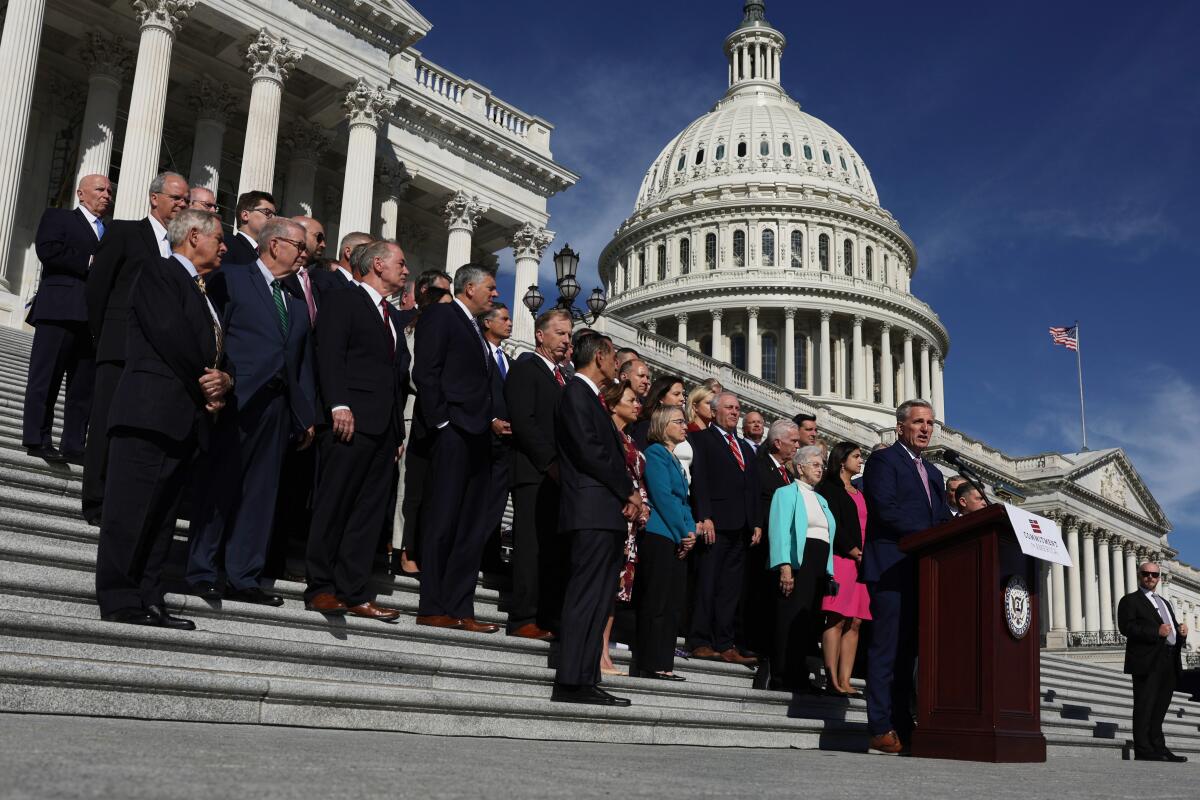Here’s why the House is likely to flip while the Senate remains up in the air

- Share via
With election day now just over five weeks away, we peer into our crystal ball — which is foggier than a summer morning in San Francisco — and answer questions.
Let’s get right to it. Will Republicans take control of Congress?
I have absolutely no clue.
So what good are you?
That’s something my bosses have been asking for years.
Seriously. Are things that uncertain?
Yes and no.
With the proviso that politics, like life, is full of surprises, it seems pretty certain Republicans will take control of the House for the first time since they lost the majority in 2018, in the last midterm election.
Defying polls and many, ahem, pundits, the GOP gained 14 House seats in 2020 even as President Trump lost the White House. (If you still insist on believing that election was stolen, you may want to quit reading here and go re-up your membership in the Flat Earth Society.)
Go on.
With that considerable head start, Republicans need only five seats to take back the House. The GOP is poised to pick up four seats just through the partisan drawing of congressional districts that followed the last census. So they’re almost there.
Heck, Republicans could gain four seats in Florida alone, where Gov. Ron DeSantis vetoed the handiwork of the GOP-run Legislature to push through a political map that’s even more egregiously slanted in the party’s favor.
Of course, Republicans are also defending a number of seats, including several in California. But it would take something close to a miracle for Democrats to hang onto the House.
As polarizer in chief, former President Trump has made voting seem more vital than ever.
What about the Senate?
That’s far less clear.
The chamber is split 50-50, with Democrats enjoying nominal control thanks to Vice President Kamala Harris, who is on permanent standby to break ties. That’s how President Biden has managed to pass a good deal of his agenda.
Yes, but what about the election?
For a time, it seemed Republicans would pick up three or more Senate seats, easily regaining the majority they lost in January 2021. (Two Georgia contests went into overtime after the November 2020 election, and Democrats won both runoffs.)
But today the fight for control seems like a toss-up.
A pair of uber-Trumpy nominees, Blake Masters in Arizona and Don Bolduc in New Hampshire, may have removed those states, which backed Biden in 2020, from the competitive category for Republicans.
Democrats are also faring better than expected, for the moment anyway, in Republican-tilting Ohio and North Carolina.
So it all comes down to the Buckeye and Tar Heel states?
Probably not.
Control of the Senate will most likely be decided by four states: Georgia, Nevada, Pennsylvania and Wisconsin. Biden carried each of those, but not by much.
In Nevada and Georgia, respectively, incumbents Catherine Cortez Masto and Raphael Warnock are defending Democratic-held seats, while Republican Ron Johnson is seeking his third term in Wisconsin. The Senate race in Pennsylvania is for an open seat held by retiring Republican Patrick J. Toomey.
Wisconsin and Pennsylvania are looking better for the GOP than they had been, as Republicans increasingly lean into the crime issue. So it could come down to Nevada and Georgia.
Well, at least we’ll know one way or the other on Nov. 8, or soon after.
Not necessarily. If no candidate wins a majority in Georgia, there will be a Dec. 6 runoff. So there may be another month of campaigning before control of the Senate is known.
The Supreme Court abortion ruling has boosted Democratic Sen. Patty Murray’s reelection hopes. Her Republican rival is focusing on inflation, crime.
Oy. What do polls show?
Surveys suggest most of the key Senate races are exceedingly close. But bear in mind, this is a highly unusual midterm election, which means any forecasts should be taken with an extra dollop of caution.
Unusual how?
There are all sorts of never-before variables.
No one alive has ever seen anything like the Jan. 6 insurrection. The Supreme Court’s June decision overturning the 50-year-old right to abortion is also without modern precedent, and has already reshaped the political landscape by energizing Democrats. Usually it’s the party out of power in Washington that is better able to rally its supporters.
And then, not least, there’s the congenitally attention-seeking Trump. He’s kept himself brashly in the news like no other ex-president, drawing at least some of the focus away from Biden ahead of the midterms, which are typically a referendum on the incumbent and his policies.
All of that has boosted Democratic hopes that November will bring something more akin to a red wavelet than a tsunami. But there’s still a considerable ways to go.
Isn’t there a cliche that goes here?
The one about so-many-days being a lifetime in politics?
That’s it!
Uh, pass.
Anything else worth noting?
There are 36 gubernatorial races. Most, however, are like California‘s, where Democrat Gavin Newsom is waltzing to reelection — which is to say they are unlikely to result in a partisan shift in power.
Two likely exceptions are Maryland and Massachusetts, blue states that seem destined to flip to Democrats after Republicans nominated Trump loyalists.
The best hopes for Republican gains appear to be in Kansas, Nevada and Wisconsin. In the meantime, an unusual three-way contest in Oregon has raised the prospect that the Democratic-leaning state could elect an independent as governor, or maybe even a Republican for the first time in 40 years.
Is your candidate winning? As the midterm election approaches, here’s how to read political polls and keep your sanity.
So much of the focus has been on Congress.
True. And that overlooks the growing importance of state races, as policies on abortion, guns and other issues are coming more and more to depend on which party holds power at that level.
Significantly, you also have several states where election deniers are running for governor, including Arizona and Wisconsin — where Republicans Kari Lake and Tim Michels, respectively, could cause all sorts of trouble if they win, gaining sway over the 2024 election in those presidential battlegrounds.
At the same time, you have Trump foot soldiers running for secretary of state in several key states — among them Arizona, Michigan and Nevada — where they would directly control the election machinery in 2024, threatening further chicanery and chaos in service of the former president’s Big Lie.
Scary!
It is. We could insert some crack here about the flat Earth, Santa Claus, the Tooth Fairy and other fictive things people believe in.
But it’s no joke.
More to Read
Get the latest from Mark Z. Barabak
Focusing on politics out West, from the Golden Gate to the U.S. Capitol.
You may occasionally receive promotional content from the Los Angeles Times.














